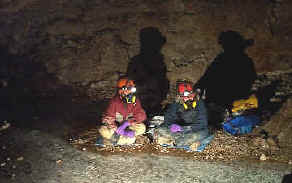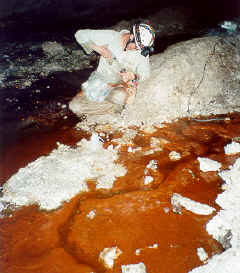Cave and Karst Geomicrobiology
The Active and Accessible Subsurface

Leave behind trees and sunlight, and venture into the darkness where life thrives!
The Kane Caves, Wyoming – the featured site for our work
We are studying several sulfidic caves that have developed in the Madison Limestone of the Bighorn Basin approximately 130 km west of Yellowstone National Park and 120 km north of Thermopolis, Wyoming, USA. The Bighorn Basin contains extensive oil fields and thermal and non-thermal springs that discharge along the flanks of the basin, and has several areas of known karstification. Most of the caves are epigenic, but several formed or were modified by sulfuric acid speleogenesis. The focus of this study is one of the caves located near Lovell, WY, where sulfidic springs and a cave stream support a rich community of microorganisms.
Other Interesting Things About Sulfur Caves

Background – introduces biogeochemical concepts to research on sulfur systems
A particularly important cave microbial community is one based on chemolithoautotrophic sulfur oxidation, where reduced sulfur compounds are used as substrates and microorganisms are able to fix carbon from carbon dioxide. Consequently, the main metabolic waste product resulting from this microbial activity is sulfuric acid.
Active Sulfidic Cave Systems – summarizes work done in other karst systems
One of the major problems interpreting caves formed by sulfuric acid speleogenesis is recognizing the mechanisms of sulfuric acid formation. However, in modern caves containing sulfidic waters, there is a wide range of microorganisms in these systems. A vast majority of them are sulfur-oxidizing bacteria that live within cave springs and streams, as well as grow on cave-wall surfaces. Some of these bacteria are reportedly acidophilic due to the production of sulfuric acid. Similar to other active sulfidic caves, we are finding evidence in the Kane Caves for a diverse ecosystem, including methanogens, sulfate-reducers, iron-oxidizers, iron-reducers, nitrogen bacteria, undifferentiated heterotrophs, as well as invertebrates such as snails and collembola.
Caves and Karst
- National Speleological Society – group dedicated to the exploration and conservation of underground resources
- American Cave Conservation Association – nonprofit organization dedicated to conserving cave and karst
- Conservation of Cave and Karst Systems – organization affiliated with the National Speleological Society
- Karst Waters Institute – site for speleologists
- National Cave and Karst Institute – new organization established to coordinate cave research
- Cave Research Foundation – non-profit group devoted to promoting cave conservation and facilitating research
- Progress of the IGCP 448 in 2000 – report describing cave and karst related research
Biospeleology – site designed to introduce people to the flora and fauna of caves - Karst-related biodiversity – includes map of karst biodiversity in the United States
- Caves in the National Parks – find a cave-related park to visit cave-related topic on the Web
- The Caving Page – site for beginners to learn more about exploring the underground
- Speleolink Page – comprehensive and frequently-updated site containing links to just about every
- Virtual Cave Tour – fabulous site for cave exploration through images and definitions
- Glossary of speleological terms – courtesy of the Australian Speleological Federation
- Cave Art – website for those interested in cave-related art
- Texas Speleological Survey – information about Texas caves and caving, including tour-cave maps
- Texas Speleological Association – group of cavers dedicated to Texas caves and karst
- Edwards Aquifer – huge groundwater system in Central Texas, full of caves and unique critters!
Microbiology
- American Society for Microbiology
- EPA Microbiology -Web site- up to the latest information on environmental microbiology
- Life in Extreme Environments – excellent site to get information on research on Earth’s extremes, with great links
- Cells Alive! – awesome site designed to introduce people to microbiology
- MicrobeWorld! – another great site to see images of bacteria

